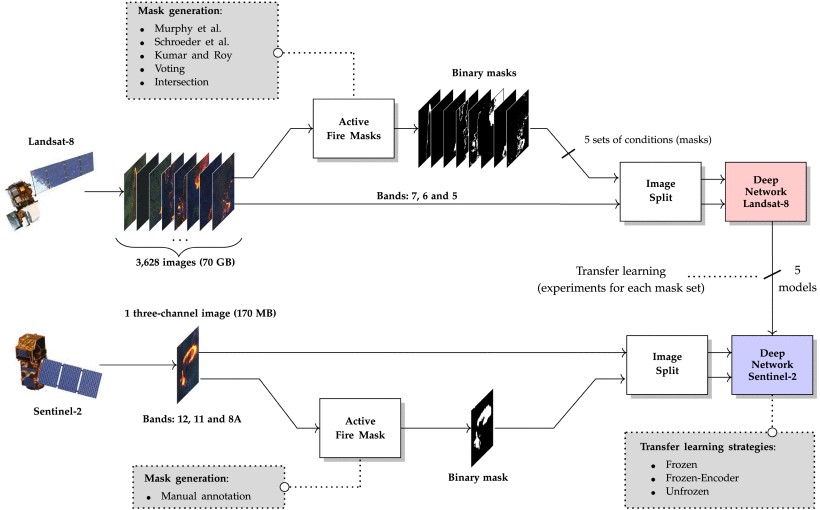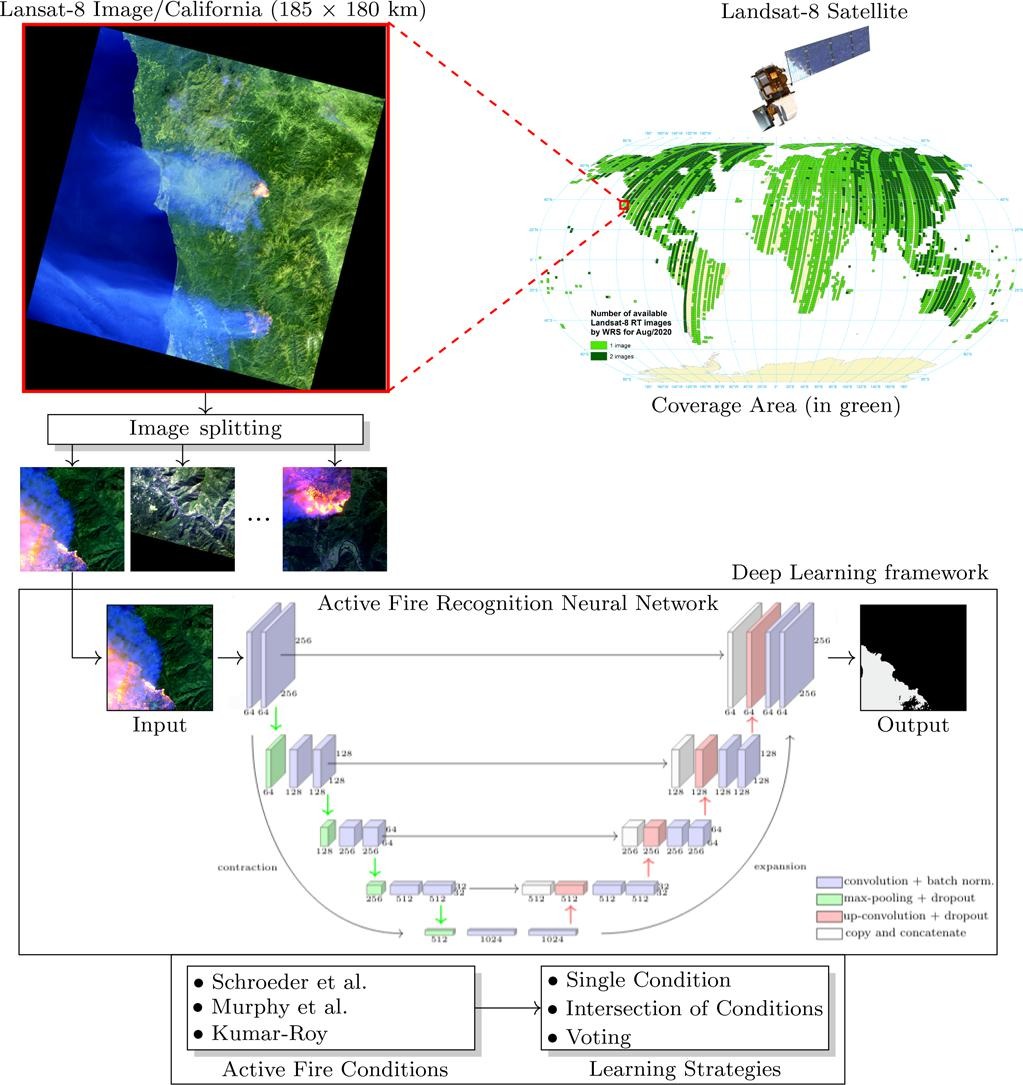André Minoro Fusioka
Hello there!
I'm André Minoro Fusioka, software developer, machine learning enthusiast, pursuing a PhD degree at the Federal University of Technology – Paraná (UTFPR).
Personal Projects
Publications

Active Fire Segmentation: A Transfer Learning Study From Landsat-8 to Sentinel-2
Published in: IEEE Journal of Selected Topics in Applied Earth Observations and Remote Sensing
DOI: 10.1109/JSTARS.2024.3436811
Abstract (Click to toggle)
Active fire segmentation through satellite imagery is fundamental to prevention and damage prediction. Algorithms to address this problem usually rely on sensor-specific thresholds, empirically chosen based on a few image samples, and thus, are susceptible to many errors. Deep learning algorithms automatically extract information through various levels of abstraction, avoiding human intervention for feature engineering. However, training a deep network from scratch requires massive labeled data, and efforts in this direction have already been made for the Landsat-8 satellite. For Sentinel-2, another important satellite that has band wavelength similarities with Landsat-8, there is a limited number of such initiatives, with few studies even concerning hand-crafted (traditional) algorithms. In this context, we explored in this article the transfer of knowledge for active fire segmentation from Landsat-8 to Sentinel-2, avoiding the need of a vast amount of labeled data from Sentinel-2, and also reducing the computational resources for training. We also compiled a benchmark containing 12 584 image patches extracted from 26 Sentinel-2 images from around the globe, along with manually annotated fire pixels, to assess the algorithm's response compared to a human specialist. In a series of transfer learning experiments by using the U-Net architecture, we showed that even a single labeled image from Sentinel-2 for training was sufficient to allow achieving an F -score metric of 84.9% when Landsat-8 knowledge is transferred and further fine-tuned in the machine learning process, while the best hand-crafted algorithm designed for Sentinel-2 achieved an F -score of 75.8% in the segmentation task.

Sentinel-2 Active Fire Segmentation: Analyzing Convolutional and Transformer Architectures, Knowledge Transfer, Fine-Tuning, and Seam Lines
Published in: IEEE Geoscience and Remote Sensing Letters
DOI: 10.1109/LGRS.2024.3443775
Abstract (Click to toggle)
Active fire segmentation in satellite imagery is a critical remote sensing task, providing essential support for planning, decision-making, and policy development. Several techniques have been proposed for this problem over the years, generally based on specific equations and thresholds, which are sometimes empirically chosen. Some satellites, such as MODIS and Landsat-8, have consolidated algorithms for this task. However, for other important satellites such as Sentinel-2, this is still an open problem. In this letter, we explore the possibility of using transfer learning to train convolutional and transformer-based deep architectures (U-Net, DeepLabV3+, and SegFormer) for active fire segmentation. We pretrain these architectures based on Landsat-8 images and automatically labeled samples and fine-tune them to Sentinel-2 images. The experiments show that the proposed method achieves F1 -scores of up to 88.4% for Sentinel-2 images, outperforming three threshold-based algorithms by at least 19% while maintaining a low demand for manually labeled samples. We also address detection over seam-line regions that present a particular challenge for existing methods. The source code and trained models are available at https://github.com/Minoro/l8tos2-transf-seamlines.

Active fire detection in Landsat-8 imagery: A large-scale dataset and a deep-learning study
Published in: ISPRS Journal of Photogrammetry and Remote Sensin
DOI: 10.1016/j.isprsjprs.2021.06.002
Abstract (Click to toggle)
Active fire segmentation in satellite imagery is a critical remote sensing task, providing essential support for planning, decision-making, and policy development. Several techniques have been proposed for this problem over the years, generally based on specific equations and thresholds, which are sometimes empirically chosen. Some satellites, such as MODIS and Landsat-8, have consolidated algorithms for this task. However, for other important satellites such as Sentinel-2, this is still an open problem. In this letter, we explore the possibility of using transfer learning to train convolutional and transformer-based deep architectures (U-Net, DeepLabV3+, and SegFormer) for active fire segmentation. We pretrain these architectures based on Landsat-8 images and automatically labeled samples and fine-tune them to Sentinel-2 images. The experiments show that the proposed method achieves F1 -scores of up to 88.4% for Sentinel-2 images, outperforming three threshold-based algorithms by at least 19% while maintaining a low demand for manually labeled samples. We also address detection over seam-line regions that present a particular challenge for existing methods. The source code and trained models are available at https://github.com/Minoro/l8tos2-transf-seamlines.
Timeline
2024 - Present
Information Technology Analyst at SERPRO
2022 - Present
PhD student at Federal University of Technology - Paraná (UTFPR)
2023
1st place in Kaggle competition - CrowdSec
2019 - 2021
Master's Degree in Applied Computer Science at Federal University of Technology - Paraná (UTFPR)
2017 - 2024
IT Analyst at PARANACIDADE
2016 - 2017
Postgraduate (Lato Sensu) in Web Development Technologies at University North of Paraná (Unopar)
2016 - 2017
Web Developer at MKX E-Commerce
2012 - 2016
Bachelor's degree in Computer Science at State University of Londrina (UEL)